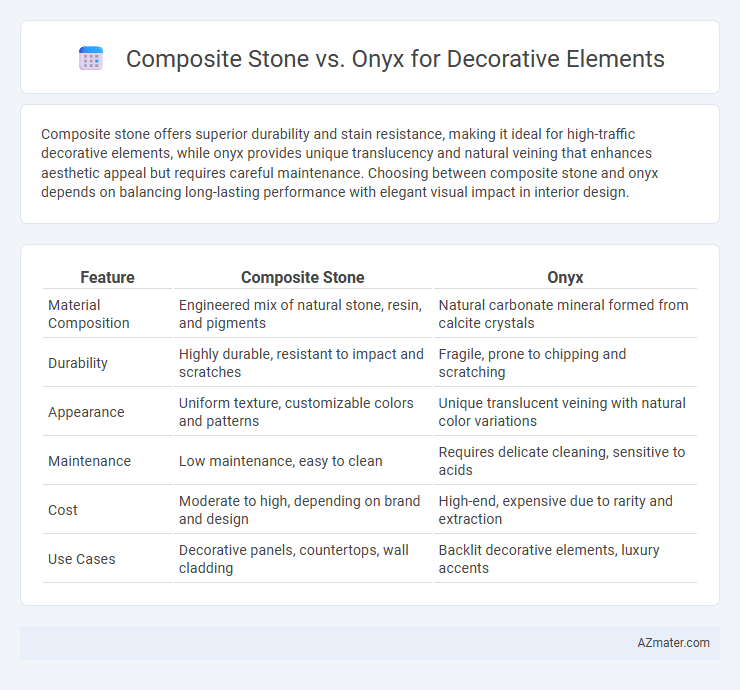Composite stone offers superior durability and stain resistance, making it ideal for high-traffic decorative elements, while onyx provides unique translucency and natural veining that enhances aesthetic appeal but requires careful maintenance. Choosing between composite stone and onyx depends on balancing long-lasting performance with elegant visual impact in interior design.
Table of Comparison
| Feature | Composite Stone | Onyx |
|---|---|---|
| Material Composition | Engineered mix of natural stone, resin, and pigments | Natural carbonate mineral formed from calcite crystals |
| Durability | Highly durable, resistant to impact and scratches | Fragile, prone to chipping and scratching |
| Appearance | Uniform texture, customizable colors and patterns | Unique translucent veining with natural color variations |
| Maintenance | Low maintenance, easy to clean | Requires delicate cleaning, sensitive to acids |
| Cost | Moderate to high, depending on brand and design | High-end, expensive due to rarity and extraction |
| Use Cases | Decorative panels, countertops, wall cladding | Backlit decorative elements, luxury accents |
Introduction to Composite Stone and Onyx
Composite stone, a man-made material composed of crushed natural stones bonded with resin, offers superior durability and customizable aesthetic options compared to natural stones. Onyx, a translucent natural stone prized for its unique veining and luminous qualities, provides a luxurious and elegant appearance but requires careful maintenance due to its softness and porosity. Choosing between composite stone and onyx for decorative elements depends on balancing factors like durability, cost, and desired visual impact.
Key Differences Between Composite Stone and Onyx
Composite stone is engineered from natural stone fragments mixed with resins, offering high durability and resistance to stains and scratches, making it ideal for high-traffic decorative elements. Onyx, a natural carbonate stone, is prized for its translucent beauty and unique veining patterns but is softer and more prone to scratching and etching. Key differences include composite stone's superior strength and low maintenance versus onyx's luxurious aesthetic and need for careful handling in decorative applications.
Visual Appeal and Aesthetic Versatility
Composite stone offers a consistent, customizable appearance with a wide range of colors and patterns, making it highly versatile for various decorative styles. Onyx features translucent qualities and unique natural veining that create luxurious, dramatic visual effects, especially when backlit. The choice between composite stone and onyx depends on the desired balance between uniformity and natural elegance for decorative elements.
Durability and Longevity Comparison
Composite stone exhibits superior durability compared to onyx, boasting high resistance to scratches, stains, and impact, making it ideal for long-term decorative applications. Onyx, a natural stone with a delicate crystalline structure, is prone to chipping, scratching, and weathering under regular use, leading to reduced longevity in high-traffic areas. Choosing composite stone ensures sustained aesthetic appeal and structural integrity for decorative elements subjected to frequent wear and environmental exposure.
Maintenance and Care Requirements
Composite stone offers low maintenance with high resistance to stains, scratches, and moisture, making it ideal for decorative elements in high-traffic areas. Onyx requires more care due to its porous nature, demanding regular sealing and gentle cleaning to prevent etching and discoloration from acidic substances. Choosing composite stone reduces long-term upkeep costs, while onyx provides unique translucency but necessitates mindful maintenance to preserve its appearance.
Cost and Value Considerations
Composite stone offers an affordable and durable alternative to onyx, providing a wide range of color options and lower maintenance costs, making it a popular choice for budget-conscious decorative projects. Onyx, prized for its unique translucency and natural veining, commands a higher price due to its rarity and fragility, which often requires specialized installation and care. Evaluating cost-effectiveness involves balancing composite stone's long-term durability and value against onyx's premium aesthetic and exclusivity in luxury interior design.
Suitability for Various Decorative Applications
Composite stone offers superior durability and low maintenance, making it ideal for high-traffic decorative applications such as countertops, flooring, and wall cladding. Onyx excels in aesthetic appeal with its translucent properties, best suited for backlit panels, accent walls, and intricate decorative features that require visual impact. Choosing between composite stone and onyx depends on balancing durability needs with desired artistic effects in various interior design projects.
Customization Options and Design Flexibility
Composite stone offers extensive customization options with its ability to mimic natural stone patterns and a wide range of colors and textures, making it ideal for tailored decorative elements. Onyx provides unique translucency and natural veining that lend an exquisite, luxurious aesthetic, but customization is limited to cutting and backlighting techniques. Both materials allow design flexibility, with composite stone suited for intricate shapes and durable installations, while onyx excels in creating dramatic, light-enhanced features.
Environmental Impact and Sustainability
Composite stone offers a more sustainable option compared to onyx due to its use of recycled materials and lower energy consumption during production. Onyx, being a natural stone, requires extensive quarrying that disrupts ecosystems and generates significant carbon emissions. Choosing composite stone reduces environmental impact while maintaining the aesthetic appeal of onyx for decorative elements.
Choosing the Right Material for Your Decorative Element
Composite stone offers superior durability, resistance to stains, and low maintenance, making it ideal for high-traffic decorative elements such as countertops and wall panels. Onyx provides unique translucency and natural veining with a luxurious, elegant look but requires careful handling due to its softness and susceptibility to scratches. Selecting the right material depends on balancing the need for practicality and aesthetic appeal, with composite stone suitable for functional spaces and onyx best for creating dramatic visual impact in low-traffic decorative accents.

Infographic: Composite stone vs Onyx for Decorative Element
 azmater.com
azmater.com